Driving in Sweden
In Sweden, driving is the best way to get around outside the big cities. While most roads are good, and traffic jams are rare, winter driving and animal collisions are major concerns.
Understand
In large parts of Sweden it is essential to have a car, mainly due to the long distances, but also because public transport is scarce outside populated areas. In some areas where there is public transportation, this is only active on working days, which means no or very limited public transportation on weekends and public holidays. You will encounter people of all ages and experience behind the wheel, which means some of them will drive excessively slow, well below speed limits, and perhaps even insecurely, which means they will lower their speed well in advance of a turn. Have this in mind when driving in Sweden.
Something unique for Sweden is the socalled A-traktor. It is a rebuilt (old) car where the transmission is locked, so the maximum speed is 30 km/h. An A-traktor can be legally driven from the age of 15. It must be equipped with a large red triangular warning sign on the rear end, and must give way to other traffic by driving on the shoulder of the road when necessary. The A-traktor is mostly common in the countryside.
Legal requirements
All motor vehicles in Sweden must have their headlights on at all times, even in the middle of the day. Modern Swedish-sold cars always have the lights turned on automatically (unless you actively turn it off), so if you rent a car in Sweden you won't have to worry about it. If you drive without lights you may find other drivers flashing their headlights at you to inform you. If your car is fitted with daytime running lights these are sufficient in daytime.
It is mandatory that both driver and passengers use seatbelts, when the car is equipped with them (antique cars (veteranfordon) are exempt). Crash helmets are mandatory for drivers and passengers of motorcycles. Motorcycle passengers under the age of seven may use an appropriate helmet — a riding helmet, skiing helmet or bicycle helmet.
From 1 December to 31 March all cars used in Sweden are required by law to have either studded tires or un-studded winter friction tires (or equivalent measures like snow chains). The tires must be marked, M+S, M-s, M.S, M&S, MS or Mud and Snow. This rule is valid only if the roads are considered to be in "winter conditions" by the local police, but that is so common in this period that you should not be without such tires. Transport Ministry (in English)
Be aware that there are streets in Stockholm, Uppsala and Gothenburg where studded tires are banned.
Roads
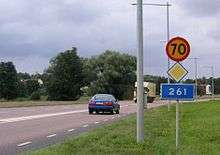
The European road network goes through Sweden, and mostly have higher standard than national or local roads. Some important roads are:
- E4 – from Helsingborg via Jönköping to Stockholm and all the way north to Haparanda at the Finnish border; see E4 through Sweden.
- E6 – from Trelleborg via Malmö to Gothenburg and Oslo, Norway; see E6 through Sweden and Norway.
- E10 – from Luleå to Riksgränsen, onwards to Narvik; see E10 through Sweden and Norway.
- E20 – from Malmö via E6 to Gothenburg, then to Stockholm, where it ends at the harbour with ferry connections to Finland, Estonia, Latvia and Russia.
- E22 – from Trelleborg via Malmö, Karlskrona to Norrköping, where it ends as an onramp to E4.
- E45 – from Gothenburg through inland Sweden to Karesuando; see E45 through Europe.
Most of the European roads outside Norrland are highways.
Second in the hierarchy are national roads (riksvägar) with two digit numbers.
The three digit numbered roads (länsvägar) come in two flavors. Major ones are numbered 100–400, minor ones with higher numbers.
Roads with numbers below 400 are marked. Roads with lower numbers are situated south of the roads with higher numbers.
The small roads, and four digit roads that might show up with numbers on your GPS map, are never marked with their numbers. They are just numbered for some administrative purpose and the numbers cannot be used while driving.
Finding directions
- The best markings are made with big blue signs with the name of the upcoming towns.
- If the road leading there is a freeway, the signs are green instead of blue.
- Unless you are going on a very big road, make your directions based on what towns or villages you are passing and keep an eye out for * these signs instead of the road numbers.
Speed limits
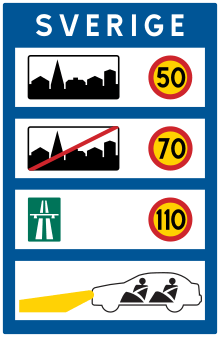
The current speed limit is very well marked by signs. The speed limit signs are in km/h. The signs you see are normally 30, 50, 70, 90 and 110. Recently, new speed limits have appeared: 40, 60, 80, 100 and 120. Two speed signs on each side of the road mean from this point this is the new speed. One sign on the right means that this is the speed on this road but there is no change in speed.
The speed limit for roads outside built-up areas is always 70 km/h unless otherwise indicated.
Since 2001 some new signs have been introduced or have been altered to also indicate the speed limit. These are:
- The freeway (motorväg) sign now also means 110 km/h.
- The highspeed road (motortrafikled) sign indicates 90 km/h (100 km/h on roads with cable fence between the lanes (since 2008).
- The new start of village sign means 50 km/h.
- The new end of village sign means 70 km/h.
With the adding of new speed limits in 2008, the signs mentioned above now follow these rules:
- The freeway (motorväg) sign is now always posted together with a sign indicating the speed limit for this road.
- The "start of village" sign is also always posted together with a speed limit sign.
The respect for the speed limit is rather poor. Often, when you are driving at the correct speed on a 70 or 90km/h road, you will constantly get passed by other cars or be urged to get out of the way to let them pass. On the other hand, speeding on 30 km/h roads is not accepted. If caught, speeding will cost you from 1500 kr (about €160), for 1–10 km/h too fast, to 4000 kr (about €430), for 36–40 km/h too fast on 70 km/h or faster roads. Speeding on slower roads is more expensive.
Road signs
Sweden follows the same convention as the rest of Europe regarding road signs, therefore they are more or less the same as for the rest of Europe (the colours vary somewhat).
The road signs in Europe differ substantially to those e.g. in the Americas. The warning signs are triangular but have symbols that should be understandable.
These are some signs that could need explanation for foreign visitors.
 Yield (give way) |
 No entry |
 No parking |
 No stopping |
 Mandatory direction |
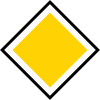 Priority road |
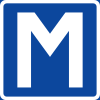 Passing place (single-track road) |
 National road (2 digits), priority road (3 digits) |
 Upcoming national or priority road |
Some useful phrases that might be found on signs
| 1 tim | 1 hour |
| Avgift | Fee |
| Gäller (även) ... | Concerns (also) ... |
| Gäller ej ... | Does not concern ... |
| Parkering förbjuden | No Parking |
| P-skiva | Parking disc |
| Utfart | Exit (for vehicles) |
| Utgång | Exit (for pedestrians) |
Drunk driving
Do not even think about driving after you have drunk even one beer. The legal limit is .02, only a quarter of that in the United States, Canada, and Britain. This limit means that you can not drink one beer at a restaurant and drive directly after. Police, at any time, can take blood by force, and if you are over the limit, it's automatic jail time.
Trucks
Lorries with trailers are often longer than in other European countries. Maximum length is 25.25 meters instead of 18 meters in continental Europe. This is the standard and does not have signs indicating a long vehicle. These vehicles are allowed on all roads unless there's a local weight or length restriction. Keep this in mind when trying to overtake. It's not uncommon to meet these lorries fully loaded with timber on narrow, curvy rural roads. If so, slow down, keep out or find a wide place to meet.
Stay safe
- See also: Winter driving, Animal collisions
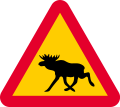
Animal collisions
Many countryside accidents are animal collisions. The biggest roads normally have fences against wild animals, but the smaller roads do not. You need to look out for deer and moose unless you want a 500 kg animal coming through the windscreen. Steer to the rear of the animal, as it might run forward when scared. In the north you will also have to watch out for reindeer. They usually travel in herds. Always slow down until all of them have passed. Reindeers are not that agile and unwilling to jump into a ditch. They will follow the road to the next level place at the roadside and then disappear into the wilderness.
Be extra careful to wild animals on the roads under these circumstances:
- Sunrise/sunset.
- Springtime (as moose reject last year's calves and give birth to new ones).
- Moose hunting season in early October.
- Edge of forests.
- Bridges across streams.
In some cases there are fences along part of the road and then the fences stop for the purpose of letting the animals pass. In such cases and in other places where wild animals are often seen there are normally warning signs.
These animals are mostly moving at dusk and dawn. While driving along lakes be especially observant as animals go for drinks at the lakes. Also, if driving in the hunting season, the wild animals might be scared by hunting parties and move around more than usual. It is normal for an ongoing hunting party to place temporary triangular traffic warning signs at the edge of roads with the text: "Jakt pågår" (ongoing hunt).
If you hit an animal and it wanders off into the woods wounded, don't forget to mark the spot where it wandered into the forest and call the police. Hitting an animal is not a crime, but not reporting it is. Your car must be fitted with a special paper ribbon (viltolycksremsa) for this purpose. The purpose for this is to be able to use dogs to hunt down the wounded animal – viltolycka.se (in Swedish only).
| “ | According to section 26 of the Hunting Act and section 40 of the Hunting Regulation, a collision between motor vehicles and bear (björn), wolf (varg), wolverine (järv), lynx (lodjur), elk (älg), red deer (kronhjort), fallow deer (dovhjort), roe deer (rådjur), otter (utter), wild boar (vildsvin), mouflon (mufflonfår) and eagle (örn) must be reported to the police even if the animal is not clearly damaged. The site of the collision must also be highlighted. Not to report a collision is punishable and fined. | ” |
—viltolycka.se | ||
Crime
While Sweden has a low to moderate crime rate, car burglaries are not unheard of. Use common sense, especially in cities, and avoid leaving valuables in the car.
Fuel
Standard fuel (drivmedel) in Sweden are 95 octane petrol (gasoline; Swedish: bensin), diesel and E85, an ethanol (etanol) fuel blend of 85% ethanol fuel and 15% petrol. Prices for petrol and diesel are high due to taxation; higher than average in Europe. Diesel is generally more expensive than petrol. 98 octane petrol is also available on some filling stations.
Fuel gas (fordonsgas) is available at 180 stations, and there are more than 2,000 public charging stations (laddstation) for electric cars — most of them in the southern parts of Sweden.
Discount filling stations like din-X, Ingo, st1, Tanka and Qstar usually have the lowest prices, but most of them are without staff and cashless. Domestic cards and credit cards like VISA and Mastercard are accepted. Premium filling stations like Circle K, Gulf, OKQ8, Preem and Shell mostly have a convenience store, a car wash and perhaps cars and trailers for rent. Those along the E4, E6, E20 and E18 European routes might also have rooms or cottages for rent. Premium filling stations that are open 24 hours daily have a sign with the text "Nattöppet" (open at night), but at night they may only have a window hatch open for business (to avoid robberies).